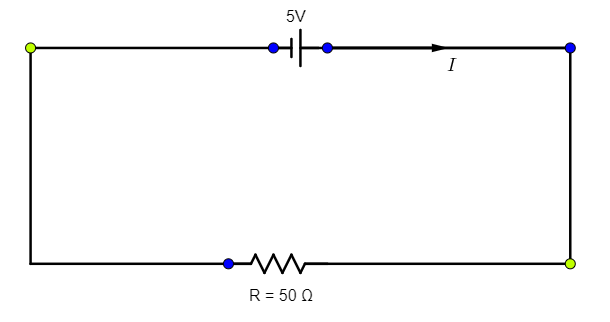
A
A.
B.
C.
D.
Answer
512.7k+ views
2 likes
Hint: A very small shunt resistance is connected in parallel with a galvanometer, which helps in increasing the range of the galvanometer. We can solve this problem by finding the current in the absence of the galvanometer and then in the presence of the galvanometer. We will then equate these two values such that they are within
Formula used:
When two resistors
When resistors are parallel, the equivalent resistance is given by,
Complete step by step answer:
We can solve this problem by first finding out the current in the absence of the galvanometer and then the current in the presence of the galvanometer.
Therefore, let us analyze the question.
Let the galvanometer resistance be
Let the shunt resistance in parallel with the galvanometer be
The potential difference in the circuit is provided by the battery. It is
Now, in the absence of the galvanometer, the circuit will look as follows.

Now,
where
Therefore, using (1), the current in the absence of the galvanometer will be
Now, in the presence of the galvanometer the circuit will be,

Now, when two resistors
When resistors are parallel, the equivalent resistance is given by,
Now, using (3) and (4), the equivalent resistance of the circuit will be,
Let the current in the circuit be
Now, according to the question,
Putting (2) and (6) in (7), we get,
Hence, a shunt resistance of
Hence, the correct option is B)
Note: Students must remember that to convert a galvanometer into an ammeter a very small shunt resistance is connected in parallel with the galvanometer. A lot of the current passes through the shunt resistance which increases the total current that can enter the galvanometer setup and hence increase the range of the formed ammeter.
On the other hand to convert a galvanometer to a voltmeter, a large resistance should be connected in series with the galvanometer. This causes a larger potential drop in the galvanometer setup which would not have been possible by the galvanometer alone. Hence, this increases the potential drop in the galvanometer setup and hence, increases the range of the voltmeter.
Formula used:
When two resistors
When resistors are parallel, the equivalent resistance is given by,
Complete step by step answer:
We can solve this problem by first finding out the current in the absence of the galvanometer and then the current in the presence of the galvanometer.
Therefore, let us analyze the question.
Let the galvanometer resistance be
Let the shunt resistance in parallel with the galvanometer be
The potential difference in the circuit is provided by the battery. It is
Now, in the absence of the galvanometer, the circuit will look as follows.

Now,
where
Therefore, using (1), the current in the absence of the galvanometer will be
Now, in the presence of the galvanometer the circuit will be,

Now, when two resistors
When resistors are parallel, the equivalent resistance is given by,
Now, using (3) and (4), the equivalent resistance of the circuit will be,
Let the current in the circuit be
Now, according to the question,
Putting (2) and (6) in (7), we get,
Hence, a shunt resistance of
Hence, the correct option is B)
Note: Students must remember that to convert a galvanometer into an ammeter a very small shunt resistance is connected in parallel with the galvanometer. A lot of the current passes through the shunt resistance which increases the total current that can enter the galvanometer setup and hence increase the range of the formed ammeter.
On the other hand to convert a galvanometer to a voltmeter, a large resistance should be connected in series with the galvanometer. This causes a larger potential drop in the galvanometer setup which would not have been possible by the galvanometer alone. Hence, this increases the potential drop in the galvanometer setup and hence, increases the range of the voltmeter.
Latest Vedantu courses for you
Grade 11 Science PCM | CBSE | SCHOOL | English
CBSE (2025-26)
School Full course for CBSE students
₹41,848 per year
Recently Updated Pages
Master Class 11 Accountancy: Engaging Questions & Answers for Success

Master Class 11 English: Engaging Questions & Answers for Success

Master Class 11 Computer Science: Engaging Questions & Answers for Success

Master Class 11 Maths: Engaging Questions & Answers for Success

Master Class 11 Social Science: Engaging Questions & Answers for Success

Master Class 11 Physics: Engaging Questions & Answers for Success

Trending doubts
Give 10 examples of unisexual and bisexual flowers

Draw a labelled sketch of the human eye class 12 physics CBSE

Differentiate between homogeneous and heterogeneous class 12 chemistry CBSE

Differentiate between insitu conservation and exsitu class 12 biology CBSE

What are the major means of transport Explain each class 12 social science CBSE

What is the difference between resemblance and sem class 12 social science CBSE




